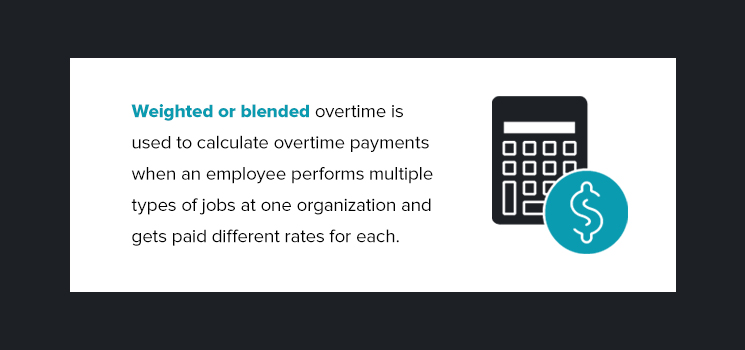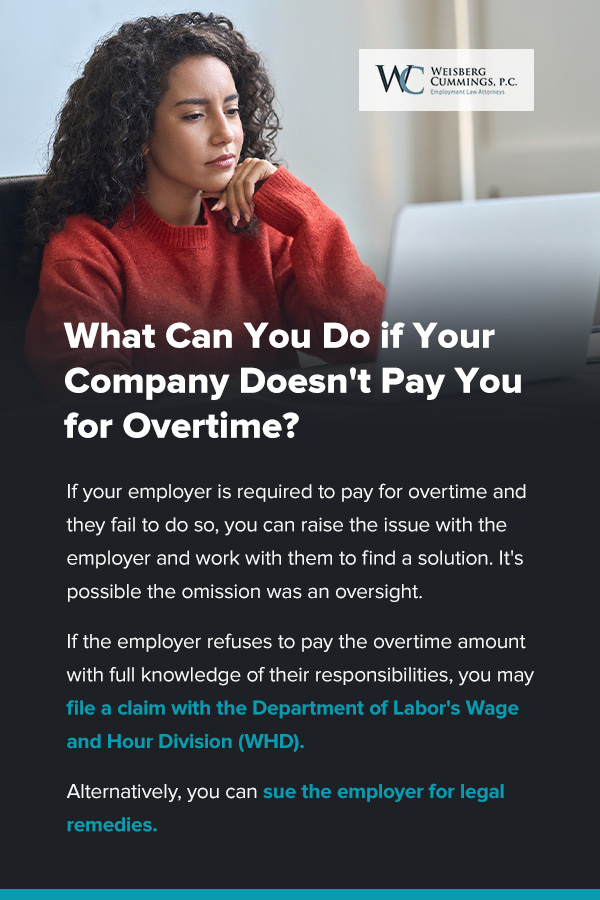By Derrek Cummings on May 11th, 2024
Overtime refers to the time worked by an employee over 40 hours per week. According to the Fair Labor Standards Act (FLSA), most employees must be paid 1.5 times their regular working wage for any work above 40 hours per week. However, in some cases, employers must use a formula to calculate weighted overtime.
If you believe your employer is not paying you overtime owed and you would like legal advice and representation, contact Weisberg Cummings, P.C. to arrange a consultation with one of our attorneys.
What Is Weighted Overtime?
Weighted or blended overtime is used to calculate overtime payments when an employee performs multiple types of jobs at one organization and gets paid different rates for each. This method allows employers to calculate the average of a worker’s different pay rates for purposes of overtime payment without having to calculate and add up the overtime pay for each rate separately. Blended overtime can also be used in situations where an employee has overtime hours and also gets tips or commission as part of their pay.
How Is Weighted Overtime Calculated?
Some payroll software will calculate weighted average overtime for employees automatically. You can also calculate overtime manually:
- Start by multiplying the hours worked in each position by their respective hourly rates. Add the sums to get the total compensation or base pay.
- Divide the base pay by the number of hours worked to get the weighted average.
- Multiply the weighted average by 1.5 to get the overtime rate. Then, multiply the overtime rate by the number of hours the employee has worked overtime to get overtime earnings.
- Multiply the weighted average by 40 hours. This is the total straight time earnings. Add this number to the overtime earnings to get the amount to be paid for overtime.
Let’s say Jane works for $15 for half of her work duties and $20 for the other half. She has worked 50 hours, meaning she has 10 hours of overtime. Here is what the formula looks like in action:
- (25 hours x $15) + (25 hours x $20) = $875
- $875 divided by 50 hours worked=$17.50 per hour
Jane’s regular hourly rate is $17.50. Multiply by 1.5 to get the overtime rate.
- $17.50 x 1.5 = $26.25 per hour
Multiply that by the number of overtime hours worked:
- $26.25 per hour x 10 hours = $262.50
$262.50 is Jane’s total overtime wages for this week. Add this to Jane’s total straight time earnings.
- $17.50 x 40 hours in a full workweek = $700
- $700 + $262.50 = $962.50
What Can You Do if Your Company Doesn’t Pay You for Overtime?
If your employer is required to pay for overtime and they fail to do so, you have a few options available. First, you can raise the issue with the employer and work with them to find a solution. It’s possible the omission was an oversight. Even if the employer deliberately refused to pay, you may be able to resolve the dispute amicably.
If the employer refuses to pay the overtime amount with full knowledge of their responsibilities, you may file a claim with the Department of Labor’s Wage and Hour Division (WHD). The agency can investigate your claim and help you recover unpaid wages. Alternatively, you can sue the employer for legal remedies.
Before filing a complaint or suing your employer, assess whether you have a valid claim. An experienced employment attorney can review your employment contract and other relevant documents like your pay stub to ascertain if you have a cause of action. A cause of action is the combination of facts that entitles a person to a legal remedy.
What Kind of Damages Can You Claim in an Unpaid Overtime Lawsuit?
You can claim compensatory damages if you sue your employer for unpaid overtime wages. Compensatory damages are awarded in civil proceedings to put the injured party in the position they would have been if the other party hadn’t breached their agreement. In this context, the damages would include back pay, which is the total amount of unpaid overtime you are owed.
There may be liquated damages. Under the FLSA, liquidated damage equals the back pay award. However, if your employer demonstrates that they acted in good faith and in reasonable belief that they were not violating the law, the court may not award liquated damages. Under the Pennsylvania Minimum Wage Act (MWA) and Wage Payment and Collection Law (WPCL), liquidated damages are an additional 25% of the back pay award, with a minimum of $500. You may recover the amount when the wages remain unpaid for more than 30 days beyond the regular payday.
If you win the lawsuit, the court may also award damages to cover the litigation cost, including court and attorney fees.
Frequently Asked Questions
Here are the answers to some commonly asked questions regarding weighted overtime pay:
When Do You Use the Weighted Average Overtime Method?
Weighted average overtime (WAOT) is the method to calculate an employee’s overtime payments when they work different positions at two different pay rates. WAOT can also be used when the employee has overtime hours and is partially compensated by non-hour based payments like commissions. Finally, if the employer pays the employee a fixed salary for a fluctuating work week, the WOAT method can be used to calculate the overtime hours on a half-time basis.
Is Overtime Pay Mandatory?
Unless exempted, employers must pay eligible employees for overtime if they work more than 40 hours in a workweek. The overtime rate must be at least 1.5 times their regular pay rates. Employers who violate the provisions of the FLSA may face legal consequences.
Contact Weisberg Cummings for Professional Support
If your employer is not paying you the overtime you are owed or if you feel there is something wrong with the way your overtime is calculated and you would like legal advice and representation, Weisberg Cummings can provide the assistance you need. With more than 40 years of combined experience, our dedicated attorneys are poised to provide responsive and personalized legal representation to clients across Pennsylvania. Contact us now for a consultation with an employment law attorney.




